Have you ever experienced the following all-too-common frustrating subrogation scenario: Your cause and origin expert determines that a fire started from a particular product but, after destructive examination of the product, your engineer is unable to identify the defect which caused the product to fail. Even though you cannot identify the specific defect, you are not necessarily out of  luck.
luck.
Courts in a number of states have long recognized that fires destroy direct physical evidence of a defect and therefore allow the product defect case to be presented with circumstantial evidence via a Malfunction Theory. Under the Malfunction Theory, if one can prove the following elements then a product liability claim still may exist:
1) The product is only a few years old;
2) The fire started inside the product;
3) Alternative ignition sources have been eliminated as a potential cause of the fire;
4) Your expert can explain how the product "could" have caused the fire even though the exact cause is unknown; and
5) The product was not misused. Often you can prove that the product was not misused if the fire started in an area where the insured did not have access to misuse it, i.e., the motor area of a microwave, the compressor area of a refrigerator, etc. However, even if the insured had access to the area of the product where the fire occurred, you can still circumvent the misuse element by showing that the insured actually did not access this area or the insured’s access of the area of origin was unrelated to the fire.
The next time a product causes a fire, but the specific defect cannot be identified, do not rush to close the file. Instead, check to see if your jurisdiction recognizes the Malfunction Theory. If so, it could turn your dead-end products claim into a functional theory of liability.



